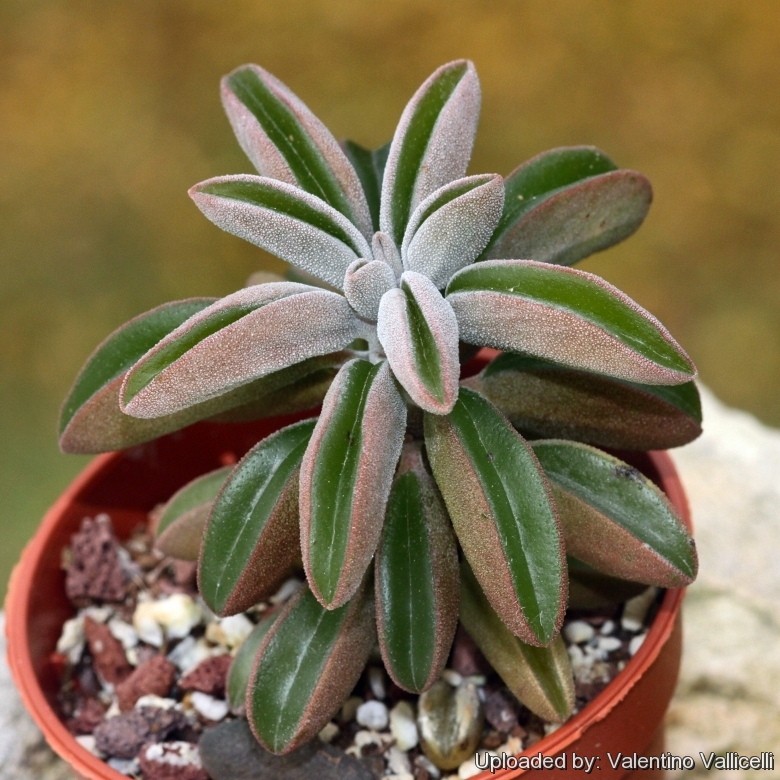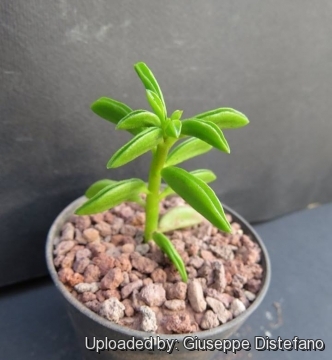Accepted Scientific Name: Peperomia dolabriformis Kunth
Nov. Gen. Sp. [H.B.K.] (quarto ed.) 1: 60, t. 4 1815. Humb., Bonpl. & Kunth

Piper dolabriforme (Peperomia dolabriformis) Photo by: Valentino Vallicelli
Origin and Habitat: Peperomia dolabriformisSN|32021]]SN|32021]] is one of the best-known succulent peperomias and has a wide distribution in the warm valleys of northern Peru.
Altitude: 600 - 1200 metres above sea level.
Habitat and ecology: This species grows as an epiphyte or as a terrestrial on rotten logs and leaf litter on the forest floor. As a forest-floor dweller this very succulent Peperomia grows best in bright diffuse light but not full sun.
Synonyms:
See all synonyms of Peperomia dolabriformis
Common Names include:
ENGLISH: Prayer peperomia
Description: Peperomia dolabriformisSN|32021]]SN|32021]] is a curious shrubby perennial, with stems becoming woody with age. The leaves are succulent, purse-shaped, light-green; the 2 halves of each leaf are fused and folded upward along the dark green margins with darker-green windows along their curved upper surface. It may be either rosette-forming, or erect laxly branched to 10-60 cm tall. Peperomia dolabriformisSN|32021]]SN|32021]] is sometimes called the "prayer peperomia" because of its plain green leaves that appear to have been folded shut, as hands in supplication.
Derivation of specific name: 'dolabriformis', from Latin 'dolabra', axe, hatchet, and Latin -formis', -shaped; for the leaf-shape = shaped like an axe, referring to the leaves.
Branches: Upright or trailing, up to 2.5 cm in diameter, glabrous, at first green, later brownish with horizontal leaf-scars.
Leaves: Sessile or with a short petiole to 6-10 mm long and 1 mm in diameter, alternate, somewhat crowded near the branch tips very fleshy, (2-)5-7(-15) cm long, 5-7(-12) mm broad, 10-14 mm thick, shaped like "pea pods", narrowly obovate in lateral view, cross-section elliptic to almost circular, folded together longitudinally so that only the under-side of the leaf is visible, the upper margins having a translucent appearance, creating a narrowly oblong 'window' along their curved upper surface which allows light to penetrate, glabrous, smooth, lime green to dark-green above, whitish to pink beneath. Apically mucronate, base rounded and tapered, veins obscure.
Inflorescences: The inflorescence is a green, slender terminal panicle to 40 cm long, with scattered small spikes. Peduncle to 1.2 cm long, partly branched. Spikes to 6 cm long, 1.5-2 mm in diameter, densely flowered. Bracteoles peltate, round.
Flowers: Inconspicuous, greenish-white erect, 'catkin-like'. Ovary immersed into the rachis.
Chromosome number: 2n = 24
Bibliography: Major references and further lectures
1) Urs Eggli “Illustrated Handbook of Succulent Plants: Dicotyledons” Springer Science & Business Media, 2002
2) Urs Eggli, Leonard E. Newton “Etymological Dictionary of Succulent Plant Names” Springer Science & Business Media, 29 June 2013
3) Clive Innes “Complete Handbook of Cacti and Succulents” Van Nostrand Reinhold Company, 01 December 1981
4) Stuart Max Walters “European Garden Flora: A Manual for the Identification of Plants Cultivated in Europe, Both Out-of-Doors and Under Glass” Cambridge University Press, 27 July 1989
 Piper dolabriforme (Peperomia dolabriformis) Photo by: Giuseppe Distefano
Piper dolabriforme (Peperomia dolabriformis) Photo by: Giuseppe DistefanoSend a photo of this plant.The gallery now contains thousands of pictures, however it is possible to do even more. We are, of course, seeking photos of species not yet shown in the gallery but not only that, we are also looking for better pictures than those already present.
Read More... Cultivation and Propagation: The succulent peperomias, like Peperomia dolabriformis, are epiphytes and require the same treatment as rhipsalis — not that of the cactus at the right. Though peperomia produce greenish-white, panicle-like flower spikes, they are grown primarily for their foliage. They are not hard to grow but avoid over-watering. If you are looking for something different in a Peperomia, this is it. In warm, sub-tropical or tropical areas, these plants maybe grown outside as a ground cover.
Soil: Requires very porous soil with excellent drainage. This plant is a forest dweller and does best with a culture that gives excellent airflow and a soil that allows the water to run quickly away from the roots and not promote sodden conditions (best soils mix used for epiphytes). These plants like to be a little pot bound. Outdoors, grow in well-drained soil in partial shade.
Watering: You must go rather easy on the watering, however, as it is rather sensitive to over- watering. Water moderately during summer but allow to dry moderately between waterings and sparingly during winter with water that is room temperature. Though you hear that these plants favour daily misting, it is not necessary, especially if room is not overly dry. Despite being very succulent it prefers not to dry out and to remain growing throughout the year.
Fertilization. Fertilize during the growing season with a balanced fertilizer.
Exposure: Thrives in filtered light with ample airflow. Avoid drafts.. Indoors, they require bright indirect light, but do tolerate low light.
Hardiness: Not particular about temperature, but best in a moderate to warm place. Protect from frost.
Uses: They are particularly attractive at the front of the bench, or on a shelf. They are also good for windowsill culture or as an accent in dish gardens.











